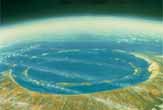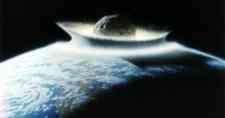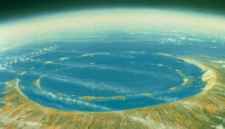 |
Ancient Asteroid Made Jell-O of Earth at Chicxulub Crater in Mexico's Yucatan By Robert Roy Britt Senior Science Writer posted: 07:00 am ET 22 November 2000 |
When a giant space rock slammed into Earth 65 million years ago near the present-day village of Chicxulub on the Yucatan Peninsula, not only did it wipe out a lot of dinosaurs, it left behind a huge crater and, inside that pock, an even bigger mystery.
A tourist in the jungle outside Chicxulub, about 200 miles (322 kilometers) west of Cancun, wouldn't see any evidence of the crater, now buried in eons of sediment. And she wouldn't suspect she was standing more than a half-mile (1 kilometer) above the center of the crater.
But scientists found the crater a decade ago using seismic monitoring equipment designed to hunt for oil. And now they have created an animated computer model that shows how the crater might have formed -- and how it would have left behind an otherwise inexplicable inner ring.
The collision
A comet or asteroid the size of a small city rocked the planet, sending giant tsunamis across the ocean and earthquakes reverberating around the globe. It also turned much of the Yucatan into mush, scientists suspect, causing rock to behave like a thick fluid.
The animation of the Chicxulub event shows how the whole thing might have happened, right up to the part where the ring mysteriously solidifies, like terrestrial Jell-O in some standard crater mold.
The ring can't be explained. Similar rings have been observed inside other craters on Earth and elsewhere in the solar system.
Clues to dino death?
The Chicxulub impact is widely believed to have triggered a mass dinosaur die-off, either through a global firestorm or through massive long-term environmental changes.
Figuring out how such a ring might form would help researchers understand the chemical and physical processes that go on during an impact, and whether and how such events might have caused mass extinctions in the past.
"This kind of research is crucial if we want to understand the environmental knock-on effects of giant impacts," said Benny Peiser, a researcher who focuses on neo-catastrophism at Liverpool John Moores University. "The truth of the matter is that despite 20 years of impact research, we are still far from knowing even the main mechanisms of impact-related mass extinctions."
Such research could also help humanity prepare for the effects of any possible future impacts, and it might also shed light on how plain old earthly landslides occur.
Next Page: How do you make rock behave like a liquid?
Hidden crater
Around 1980, Luis and Walter Alverez suggested that an impact might have been responsible for the death of the dinosaurs. The race was on to find evidence of a crater.
The Chicxulub crater was discovered 10 years later. Much of it lies under the ocean, and all of it is hidden under 65 million years of sediment. The crater is estimated to be 100 to 150 miles (160 to 240 kilometers) wide.
|
The central uplift ... collapsed itself to form a concentric ring structure analogous to the ripple formed when a sugar lump is dropped into a cup of tea." -- Gareth Collins |
Gareth Collins, a postgraduate student at Imperial College in the U.K., presented the animation at the Geological Society of America's annual meeting earlier this month. He detailed the Chicxulub event for SPACE.com:
The tremendous energy of the impact shattered the underlying bedrock into a pile of rubble -- small rocks and large boulders. It also generated vibrating acoustic waves, Collins suspects. These waves then supported the weight of the rock, reducing friction deep down in the pile and allowing the whole mess to slip around.
Collins calls the process "acoustic fluidization," and he likens it to a pile of sand. If the pile is steep enough, the grains near the top of the pile can slip. But the sand at the bottom has lots of weight pushing down on it, creating friction and holding it in place.
"In order to allow the whole sand pile to move, some process must either reduce the friction between the grains throughout the pile, or relieve the weight of the overlying sand."
Collins says the same process relieved the weight in the Chicxulub rubble pile, allowing otherwise solid material to slosh side-to-side and up-and-down.
The crater collapsed, forming a towering mound in the center that was two or three times the height of Mount Everest. An outer rim formed on the crater, some 62 miles (100 kilometers) wide.
"The central uplift would then have collapsed itself to form a concentric ring structure analogous to the ripple formed when a sugar lump is dropped into a cup of tea," Collins said. "In the case of crater collapse, however, the fluidization of the surrounding rock is only temporary -- once the fluidization ceases, the collapse is halted and the internal concentric ring structure remains."
It's this sudden solidification that leaves scientists scratching their heads.
"This research is at a very early stage and hasn't overcome the biggest difficulty," says Peiser, who was not involved in the work. "If the punctuated material turns fluid and collapses within a very short time, how can a central peak become frozen almost instantly in order to survive as a feature instead of flatten out?"
Collins worked with Jay Melosh, a geophysicist at the University of Arizona's Lunar and Planetary Laboratory, and others, to develop the computer animation based on seismic data. Collins said that while geologists are skeptical of the model, his colleagues who study asteroid impacts generally agree with the idea. Peiser acknowledges that the concept is "gaining currency."



 A new computer model shows a 5-10 minute event during which the crater collapsed inward, forcing up a central mound that soared three times the height of Mount Everest. It then collapsed down and out to produce the inner ring.
A new computer model shows a 5-10 minute event during which the crater collapsed inward, forcing up a central mound that soared three times the height of Mount Everest. It then collapsed down and out to produce the inner ring.